Integration of Membrane Bioreactor and Nanofiltration for the Treatment Process of Real Hospital Wastewater in Ho Chi Minh City, Vietnam
Abstract
:1. Introduction
2. Materials and Methods
2.1. Experimental Model
2.2. Sampling and Analysis
3. Results and Discussion
3.1. Characterization of the Active Sludge
3.2. Treatment Efficiencies of Organic Matter and Nutrients
3.3. Treatment Effectiveness of Other Pollutants
3.4. Evaluation of Membrane Resistance during Operation
4. Conclusions
Author Contributions
Funding
Acknowledgments
Conflicts of Interest
Nomenclature
| BOD | Biological oxygen demand |
| COD | Chemical oxygen demand |
| DO | Dissolved oxygen |
| F/M | Food to microorganism ratio |
| GAC | Granular active carbon |
| HRT | Hydraulic retention time |
| LRV | Log removal value |
| MBR | Membrane bioreactor |
| MF | Microfiltration |
| MLSS | Mixed liquor suspended solids |
| MLVSS | Mixed liquor volatile suspended solids |
| NF | Nanofiltration |
| OLR | Organic load rate |
| Pt-Co | Platinum-cobalt |
| RO | Reverse osmosis |
| SRT | Solid retention time |
| SVI | Sludge volume index |
| TCVN | Tieu Chuan Viet Nam (Vietnamese standards) |
| TKN | Total Kjeldahl nitrogen |
| TMP | Transmembrane Pressure |
| TP | Total phosphate |
| TSS | Total suspended solids |
References
- Kosma, C.I.; Lambropoulou, D.A.; Albanis, T.A. Occurrence and removal of PPCPs in municipal and hospital wastewaters in Greece. J. Hazard. Mater. 2010, 179, 804–817. [Google Scholar] [CrossRef] [PubMed]
- Zheng, X.; Zhou, Y.; Chen, S.; Zheng, H.; Zhou, C. Survey of MBR market: Trends and perspectives in China. Desalination 2010, 250, 609–612. [Google Scholar] [CrossRef]
- Pauwels, B.; Verstraete, W. The treatment of hospital wastewater: An appraisal. J. Water Health 2006, 4, 405–416. [Google Scholar] [CrossRef] [PubMed]
- Joss, A.; Siegrist, H.; Ternes, T. Are we about to upgrade wastewater treatment for removing organic micropollutants? Water Sci. Technol. 2008, 57. [Google Scholar] [CrossRef] [PubMed]
- Verlicchi, P.; Galletti, A.; Petrovic, M.; Barceló, D. Hospital effluents as a source of emerging pollutants: An overview of micropollutants and sustainable treatment options. J. Hydrol. 2010, 389, 416–428. [Google Scholar] [CrossRef]
- Liu, Q.; Zhou, Y.; Chen, L.; Zheng, X. Application of MBR for hospital wastewater treatment in China. Desalination 2010, 250, 605–608. [Google Scholar] [CrossRef]
- Rodriguez-Mozaz, S.; Chamorro, S.; Marti, E.; Huerta, B.; Gros, M.; Sànchez-Melsió, A.; Borrego, C.M.; Barceló, D.; Balcázar, J.L. Occurrence of antibiotics and antibiotic resistance genes in hospital and urban wastewaters and their impact on the receiving river. Water Res. 2015, 69, 234–242. [Google Scholar] [CrossRef] [PubMed]
- Nasr, M.M.; Yazdanbakhsh, A. Study on wastewater treatment systems in hospitals of Iran. J. Environ. Health Sci. Eng. 2008, 5, 211–215. [Google Scholar]
- Suarez, S.; Lema, J.M.; Omil, F. Pre-treatment of hospital wastewater by coagulation–flocculation and flotation. Bioresour. Technol. 2009, 100, 2138–2146. [Google Scholar] [CrossRef] [PubMed]
- Zhu, M.; Zhu, G.; Zhao, L.; Yao, X.; Zhang, Y.; Gao, G.; Qin, B. Influence of algal bloom degradation on nutrient release at the sediment–water interface in Lake Taihu, China. Environ. Sci. Pollut. Res. 2013, 20, 1803–1811. [Google Scholar] [CrossRef] [PubMed]
- Le Moal, M.; Gascuel-Odoux, C.; Ménesguen, A.; Souchon, Y.; Étrillard, C.; Levain, A.; Moatar, F.; Pannard, A.; Souchu, P.; Lefebvre, A.; et al. Eutrophication: A new wine in an old bottle? Sci. Total Environ. 2019, 651, 1–11. [Google Scholar] [CrossRef] [PubMed]
- Conley, D.J.; Paerl, H.W.; Howarth, R.W.; Boesch, D.F.; Seitzinger, S.P.; Havens, K.E.; Lancelot, C.; Likens, G.E. ECOLOGY: Controlling Eutrophication: Nitrogen and Phosphorus. Science 2009, 323, 1014–1015. [Google Scholar] [CrossRef] [PubMed]
- Naeem, M.; Idrees, M.; Khan, M.M.A.; Moinuddin; Ansari, A.A. Task of Mineral Nutrients in Eutrophication; Springer: Dordrecht, The Netherlands, 2014; Volume 2, pp. 223–237. [Google Scholar]
- Tchounwou, P.B.; Yedjou, C.G.; Patlolla, A.K.; Sutton, D.J. Heavy Metal Toxicity and the Environment. In Molecular, Clinical and Environmental Toxicology; Experientia Supplementum; Luch, A., Ed.; Springer: Basel, Switzerland, 2012; Volume 3, pp. 133–164. [Google Scholar]
- Krzeminski, P.; Leverette, L.; Malamis, S.; Katsou, E. Membrane bioreactors-A review on recent developments in energy reduction, fouling control, novel configurations, LCA and market prospects. J. Membrane Sci. 2017, 527, 207–227. [Google Scholar] [CrossRef]
- Ahn, W.-Y.; Kang, M.-S.; Yim, S.-K.; Choi, K.H. Advanced landfill leachate treatment using an integrated membrane process. Desalination 2002, 149, 109–114. [Google Scholar] [CrossRef]
- Wang, G.; Fan, Z.; Wu, D.; Qin, L.; Zhang, G.; Gao, C.; Meng, Q. Anoxic/aerobic granular active carbon assisted MBR integrated with nanofiltration and reverse osmosis for advanced treatment of municipal landfill leachate. Desalination 2014, 349, 136–144. [Google Scholar] [CrossRef]
- Alturki, A.A.; Tadkaew, N.; McDonald, J.A.; Khan, S.J.; Price, W.E.; Nghiem, L.D. Combining MBR and NF/RO membrane filtration for the removal of trace organics in indirect potable water reuse applications. J. Membr. Sci. 2010, 365, 206–215. [Google Scholar] [CrossRef]
- Wang, Y.; Wang, X.; Li, M.; Dong, J.; Sun, C.; Chen, G. Removal of Pharmaceutical and Personal Care Products (PPCPs) from Municipal Waste Water with Integrated Membrane Systems, MBR-RO/NF. Int. J. Environ. Res. Public Health 2018, 15. [Google Scholar] [CrossRef] [PubMed]
- Patterson, C.; Anderson, A.; Sinha, R.; Muhammad, N.; Pearson, D. Nanofiltration Membranes for Removal of Color and Pathogens in Small Public Drinking Water Sources. J. Environ. Sci. 2012, 138, 48–57. [Google Scholar] [CrossRef]
- Lan, Y.; Groenen-Serrano, K.; Coetsier, C.; Causserand, C. Nanofiltration performances after membrane bioreactor for hospital wastewater treatment: Fouling mechanisms and the quantitative link between stable fluxes and the water matrix. Water Res. 2018, 146, 77–87. [Google Scholar] [CrossRef] [PubMed]
- Kovalova, L.; Siegrist, H.; Singer, H.; Wittmer, A.; McArdell, C.S. Hospital wastewater treatment by membrane bioreactor: Performance and efficiency for organic micropollutant elimination. Environ. Sci. Technol. 2012, 46, 1536–1545. [Google Scholar] [CrossRef] [PubMed]
- Snyder, S.A.; Adham, S.; Redding, A.M.; Cannon, F.S.; DeCarolis, J.; Oppenheimer, J.; Wert, E.C.; Yoon, Y. Role of membranes and activated carbon in the removal of endocrine disruptors and pharmaceuticals. Desalination 2007, 202, 156–181. [Google Scholar] [CrossRef]
- Chon, K.; Sarp, S.; Lee, S.; Lee, J.-H.; Lopez-Ramirez, J.A.; Cho, J. Evaluation of a membrane bioreactor and nanofiltration for municipal wastewater reclamation: Trace contaminant control and fouling mitigation. Desalination 2011, 272, 128–134. [Google Scholar] [CrossRef]
- Cartagena, P.; El Kaddouri, M.; Cases, V.; Trapote, A.; Prats, D. Reduction of emerging micropollutants, organic matter, nutrients and salinity from real wastewater by combined MBR–NF/RO treatment. Sep. Purif. Technol. 2013, 110, 132–143. [Google Scholar] [CrossRef]
- Ngoc, N.N.; Van Cach, N.; Ha, T.L.; Giang, P.T.T. Microbiologycal characterization and potential application of indigenous B. Methylotrophycus Ba1 in handling of Canna Edulis. Ker processing craft village wastewater. J. Forestry Sci. Technol. 2016, 5, 3–9. [Google Scholar]
- Nguyen, T.-T.; Bui, X.-T.; Luu, V.-P.; Nguyen, P.-D.; Guo, W.; Ngo, H.-H. Removal of antibiotics in sponge membrane bioreactors treating hospital wastewater: Comparison between hollow fiber and flat sheet membrane systems. Bioresource Technol. 2017, 240, 42–49. [Google Scholar] [CrossRef] [PubMed]
- Choi, J.-H.; Fukushi, K.; Ng, H.; Yamamoto, K. Evaluation of a long-term operation of a submerged nanofiltration membrane bioreactor (NF MBR) for advanced wastewater treatment. Water Sci. Technol. 2006, 53, 131–136. [Google Scholar] [CrossRef] [PubMed]
- Wang, J.; Li, K.; Wei, Y.; Cheng, Y.; Wei, D.; Li, M. Performance and fate of organics in a pilot MBR–NF for treating antibiotic production wastewater with recycling NF concentrate. Chemosphere 2015, 121, 92–100. [Google Scholar] [CrossRef] [PubMed] [Green Version]
- Al Qarni, H.; Collier, P.; O’Keeffe, J.; Akunna, J. Investigating the removal of some pharmaceutical compounds in hospital wastewater treatment plants operating in Saudi Arabia. Environ. Sci. Pollut. Res. Int. 2016, 23, 13003–13014. [Google Scholar] [CrossRef] [PubMed] [Green Version]

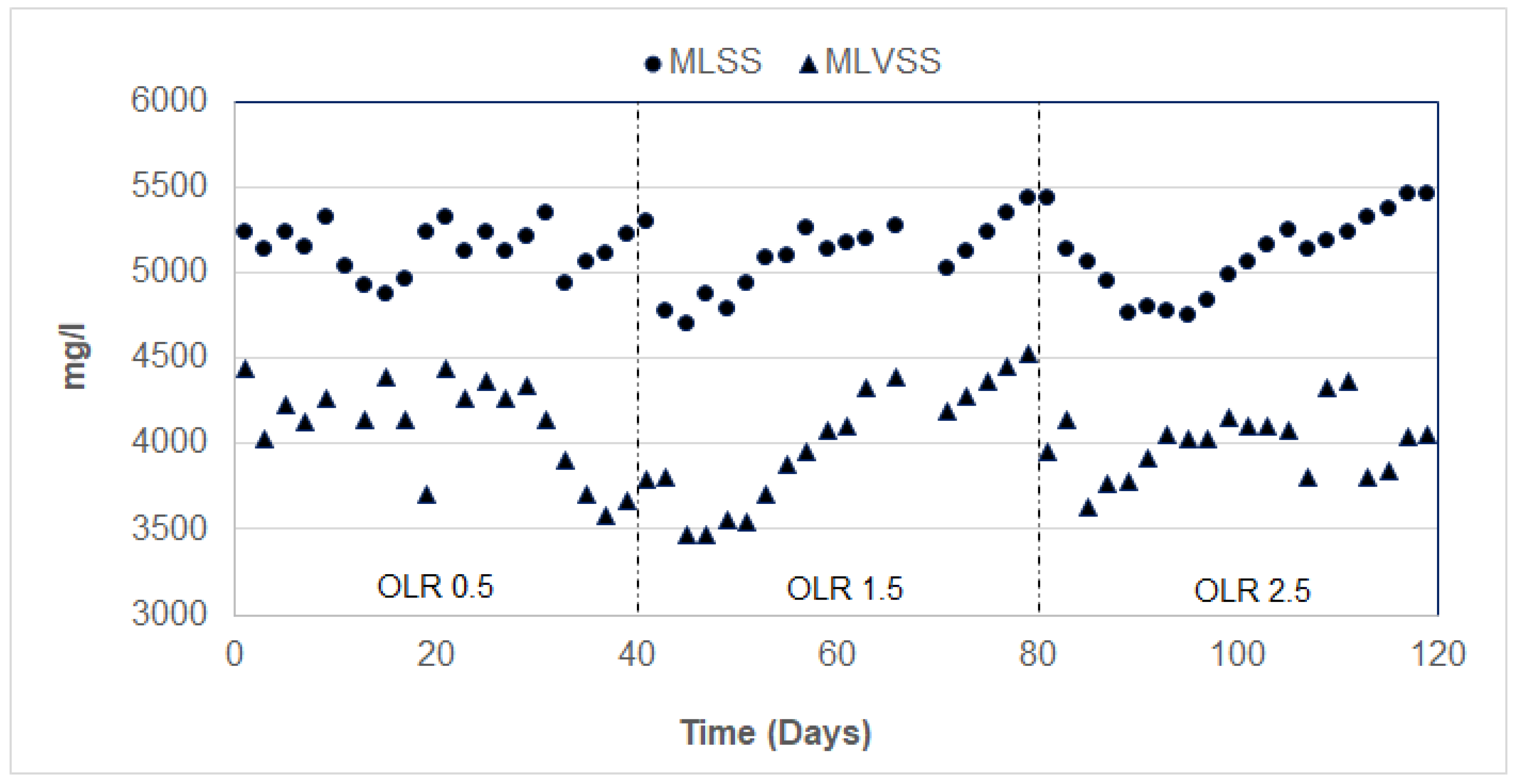

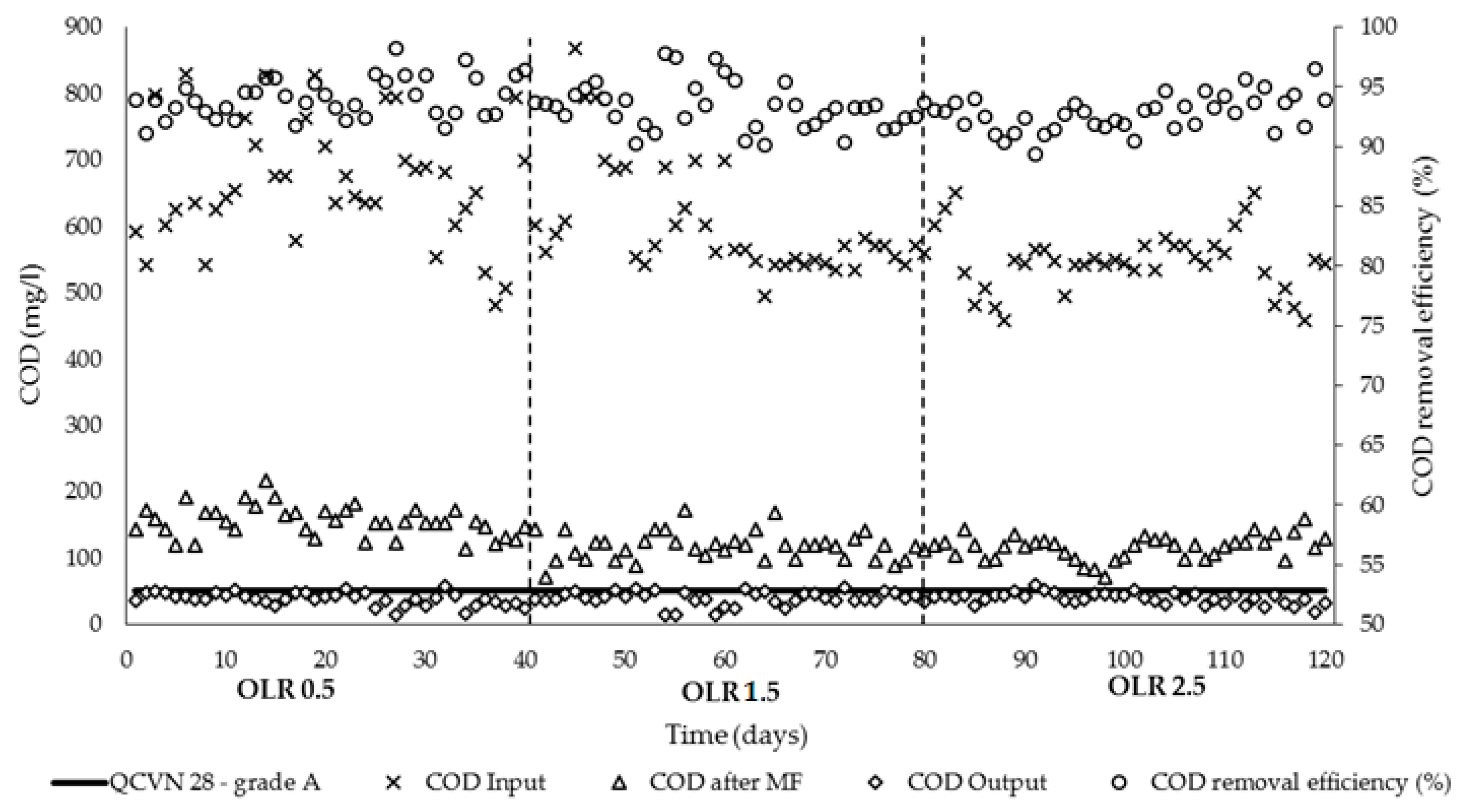

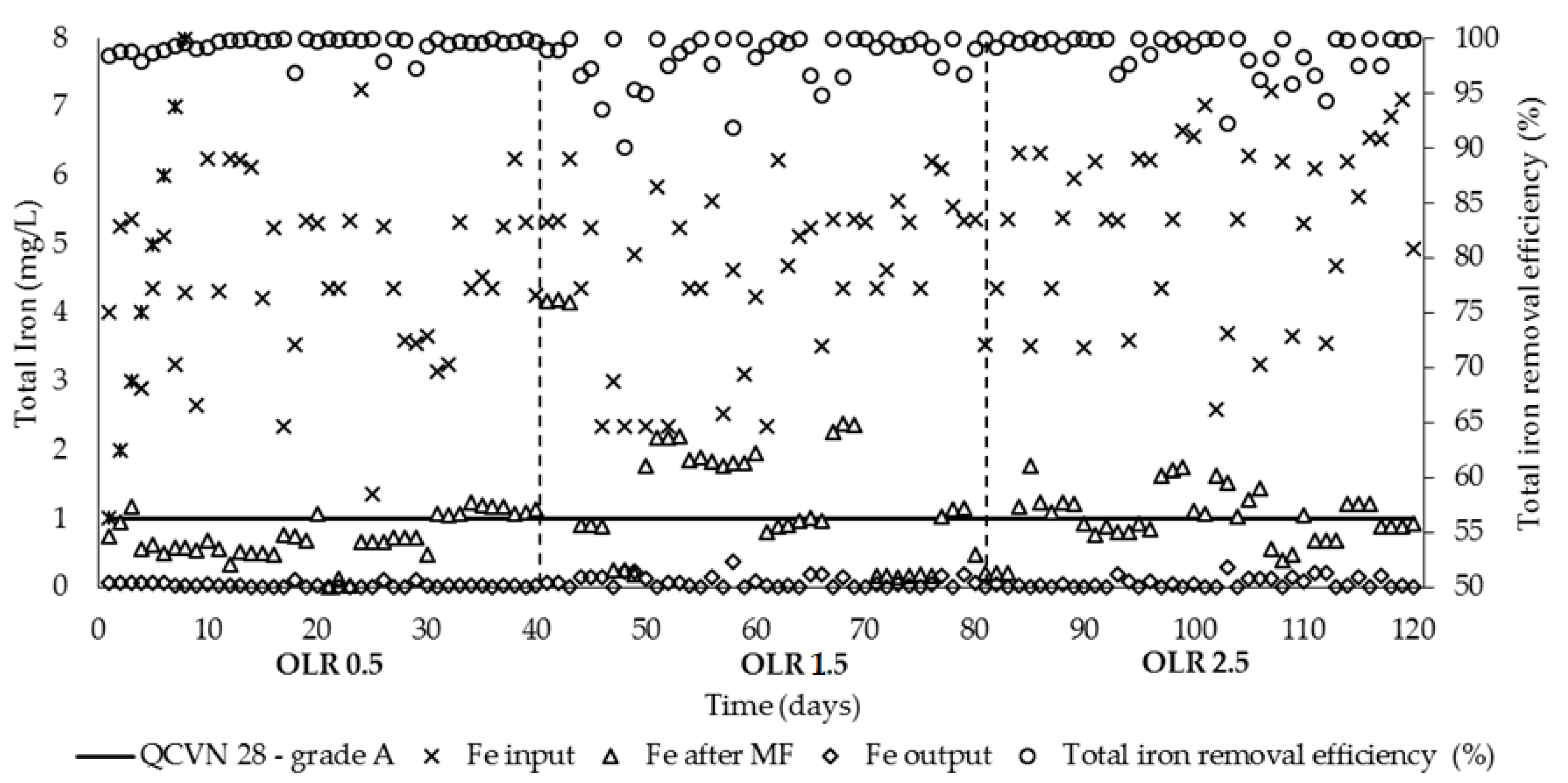

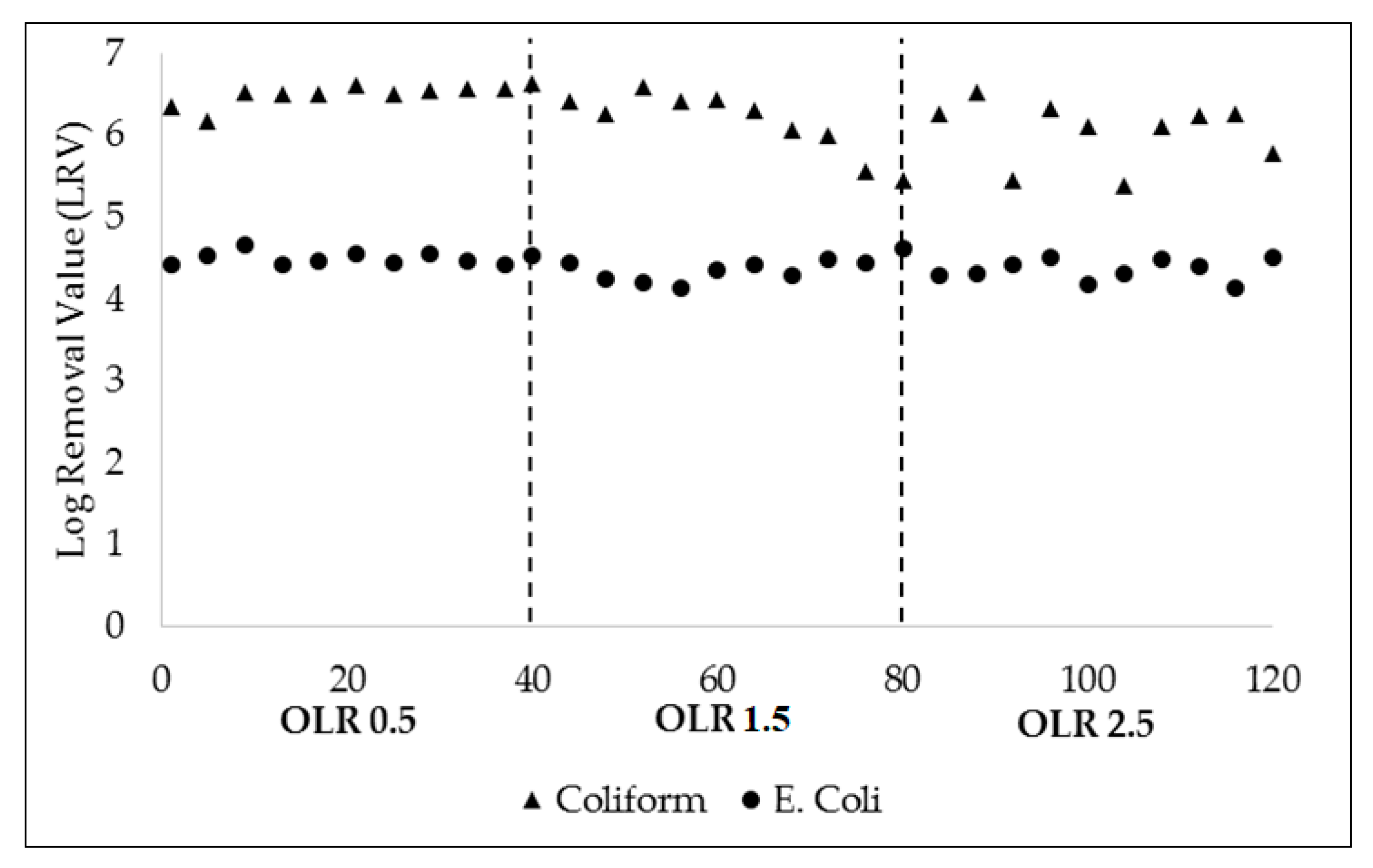
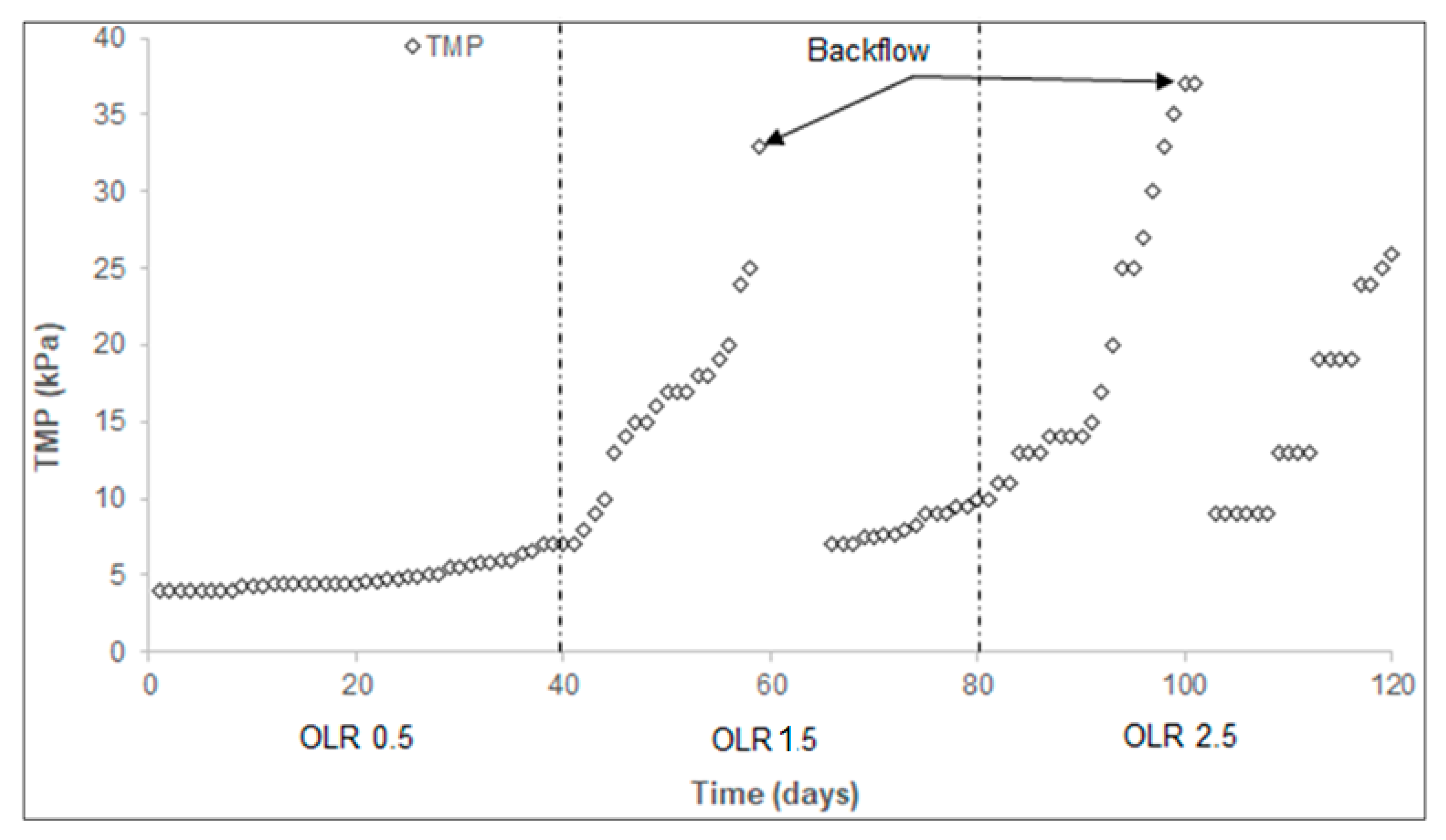
| Parameter | Unit | Organic Load Rate | ||
|---|---|---|---|---|
| OLR1 | OLR2 | OLR3 | ||
| Q | litre/day | 2.4 | 6.3 | 10.5 |
| F/M | day−1 | 0.003 ± 0.0001 | 0.006 ± 0.0009 | 0.010 ± 0.00011 |
| OLR | kgCOD/m3day | 0.5 | 1.5 | 2.5 |
| HRT | Hour | 24 | 8.0 | 4.8 |
| MLSS | mg/l | 5041.6 ± 137.9 | 5101.9 ± 209.5 | 5110.8 ± 241 |
| pH | - | 7.2 ± 0.4 | 7.5 ± 0.5 | 7.5 ± 0.4 |
| DO | mg/l | 5.2 ± 0.5 | 4.7 ± 0.2 | 4.9 ± 0.3 |
| SRT | Days | 40 | 40 | 40 |
| Parameter | Concentrations of Nitrogen Compounds | QCVN 28: 2010/MONRE (Grade A) | |||
|---|---|---|---|---|---|
| OLR 0.5 | OLR 1.5 | OLR 2.5 | |||
| NH4+-N (mg/L) | in | 22.8 ± 4.4 | 23.7 ± 3.2 | 25.0 ± 3.2 | 5 |
| out | 0.2 ± 0.3 | 0.3 ± 0.3 | 0.2 ± 0.2 | 5 | |
| NO2−-N (mg/L) | in | 0.67 ± 0.26 | 0.70 ± 0.26 | 0.74 ± 0.33 | - |
| out | 0.36 ± 0.27 | 0.14 ± 0.19 | 0.02 ± 0.03 | - | |
| NO3−-N (mg/L) | in | 0.20 ± 0.20 | 0.22 ± 0.25 | 0.16 ± 0.29 | 30 |
| out | 4.91 ± 0.61 | 4.50 ± 0.50 | 3.90 ± 0.62 | 30 | |
| TKN (mg/L) | in | 37.7 ± 5.6 | 37.5 ± 4.8 | 40.1 ± 6.8 | - |
| out | 5.0 ± 0.8 | 4.5 ± 0.5 | 2.9 ± 0.7 | - | |
| TN (mg/L) | in | 35.84 ± 5.51 | 38.43 ± 4.84 | 41.04 ± 6.88 | - |
| out | 9.46 ± 1.45 | 8.14 ± 1.11 | 6.81 ± 1.13 | - | |
© 2019 by the authors. Licensee MDPI, Basel, Switzerland. This article is an open access article distributed under the terms and conditions of the Creative Commons Attribution (CC BY) license (http://creativecommons.org/licenses/by/4.0/).
Share and Cite
Tran, T.; Nguyen, T.B.; Ho, H.L.; Le, D.A.; Lam, T.D.; Nguyen, D.C.; Hoang, A.T.; Do, T.S.; Hoang, L.; Nguyen, T.D.; et al. Integration of Membrane Bioreactor and Nanofiltration for the Treatment Process of Real Hospital Wastewater in Ho Chi Minh City, Vietnam. Processes 2019, 7, 123. https://doi.org/10.3390/pr7030123
Tran T, Nguyen TB, Ho HL, Le DA, Lam TD, Nguyen DC, Hoang AT, Do TS, Hoang L, Nguyen TD, et al. Integration of Membrane Bioreactor and Nanofiltration for the Treatment Process of Real Hospital Wastewater in Ho Chi Minh City, Vietnam. Processes. 2019; 7(3):123. https://doi.org/10.3390/pr7030123
Chicago/Turabian StyleTran, Thanh, Thanh Binh Nguyen, Huu Loc Ho, Duc Anh Le, Tri Duc Lam, Duy Chinh Nguyen, Anh Tuan Hoang, Trung Sy Do, Luong Hoang, Trinh Duy Nguyen, and et al. 2019. "Integration of Membrane Bioreactor and Nanofiltration for the Treatment Process of Real Hospital Wastewater in Ho Chi Minh City, Vietnam" Processes 7, no. 3: 123. https://doi.org/10.3390/pr7030123





